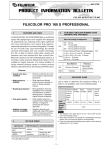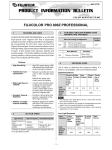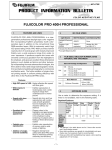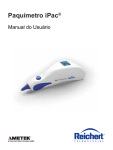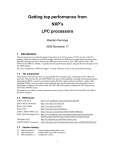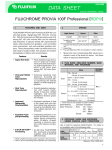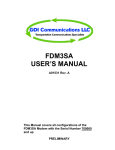Download (MMI) Devices
Transcript
APSS Apollo Application Note on Multi-Mode Interference (MMI) Devices Design, simulation and layout APN-APSS-MMI Apollo Inc. 1057 Main Street West Hamilton, Ontario L8S 1B7 Canada Tel: (905)-524-3030 Fax: (905)-524-3050 www.apollophotonics.com MMI DEVICE Disclaimer In no event should Apollo Inc., its employees, its contractors, or the authors of this documentation be liable to you for general, special, direct, indirect, incidental or consequential damages, losses, costs, charges, claims, demands, or claim for lost profits, fees, or expenses of any nature or kind. Document Revision: July 2, 2003 Copyright © 2003 Apollo Inc. All right reserved. No part of this document may be reproduced, modified or redistributed in any form or by whatever means without prior written approval of Apollo Inc. © Apollo Inc. Page 2 of 26 APN-APSS-MMI MMI DEVICE Abstract This application note provides an overview and an example of how to design, simulate, and optimize multi-mode interference (MMI) devices using a pre-defined model in the Device Module of the Apollo Photonics Solution Suite (APSS). This application note: • describes the operation principle, basic design consideration, and performance parameters for MMI devices • presents the basic design process for MMI-based devices, based on analytical and numerical methods • discusses key issues related to MMI-based devices, such as power splitters, power couplers, and wavelength multiplexers • outlines design steps specific to the design of MMI-based devices, such as import projects, solver settings, and display of simulation results • provides a typical example and simulation results, which can then be compared with published papers The APSS application consists of four different modules: Material, Waveguide, Device, and Circuit. Because each module specializes in different specific design tasks, APSS can handle almost any kind of device made from almost any kind of material. Keywords APSS, device module, multi-mode interference (MMI) device, power splitter, coupler, switch, multiplexer, excess loss, crosstalk, strongly and weakly guided waveguides, analytical method, numerical method © Apollo Inc. Page 3 of 26 APN-APSS-MMI MMI DEVICE Table of Contents 1 INTRODUCTION..................................................................................................... 5 2 THEORY ................................................................................................................... 5 2.1 2.2 2.3 3 DESIGN AND SIMULATION .............................................................................. 10 3.1 3.2 3.3 3.4 3.5 3.6 4 OPERATION PRINCIPLE ......................................................................................... 5 BASIC DESIGN CONSIDERATIONS .......................................................................... 7 PERFORMANCE PARAMETERS ............................................................................... 8 OVERALL DESIGN ............................................................................................... 10 POWER SPLITTER ................................................................................................ 10 POWER COUPLER ................................................................................................ 11 NON-UNIFORM POWER SPLITTER ........................................................................ 11 WAVELENGTH MULTIPLEXER ............................................................................. 12 SIMULATION AND OPTIMIZATION ....................................................................... 13 EXAMPLE............................................................................................................... 15 4.1 4.2 4.3 4.4 MATERIAL AND WAVEGUIDE DESIGN ................................................................. 15 CREATION OF PREDEFINED DEVICE..................................................................... 18 SOLVER SETTINGS OF PREDEFINED DEVICE......................................................... 19 RUN AND DISPLAY ............................................................................................. 21 5 CONCLUSION ....................................................................................................... 26 6 REFERENCES........................................................................................................ 26 © Apollo Inc. Page 4 of 26 APN-APSS-MMI MMI DEVICE 1 Introduction Multi-mode interference (MMI) devices have been extensively studied and are of considerable interest as key optical components in photonic integrated circuits (PICs). The principle of the MMI devices is based on destructive/constructive interferences occurring in the MMI area with a large number of multi-modes. Because of its unique properties, such as low insertion loss, large optical bandwidths, compactness, polarization insensitivity, low crosstalk, and excellent fabrication tolerances, the MMI device has many potential applications such as couplers, splitters, combiners, mode converters, filters, and routers [1]. They can also be easily fabricated in more complex PICs such as ring lasers, optical modulators, MZI (Mach-Zehnder interferometer) switches, dense wavelength multiplexers, and wavelength converters. 2 Theory In this section, the operation principle of the MMI devices is described. Basic design considerations and performance parameters for MMI-based devices are also provided. 2.1 Operation principle The operation principle of the MMI device is based on self-imaging, which is a property of multimode waveguides. For sake of simplicity, the simple 1x1 rectangular shape MMI device, as shown in Figure 1, is used to illustrate the operation principle. The MMI device generally consists of three parts: input ports (or left ports), a MMI area output ports (or right ports). The typical, practical MMI device is usually an M-input-and-Noutput device with tapered functions. There are three kinds of MMI devices, which allow different interferences. Note: For more information about the detailed categories and basic solver setting of the MMI devices, please refer to the “MMI” pre-defined model in the Device Module section of APSS manual. © Apollo Inc. Page 5 of 26 APN-APSS-MMI MMI DEVICE S z L D2 D1 Port 1 W1 W MMI Area W2 Port 2 We nr nc y Figure 1 Schematic diagram of a MMI device Here the guided-mode propagation method (MPA), one of the analytical methods, is used to illustrate the self-imaging effect in the MMI device. In this approach, the propagation constants β i (i= 0, 1, 2, 3, …, N, where N is the number of guided modes) of multi-modes in the MMI area are given in the paraxial approximation by [1]: i (i + 2)π Eq. 1 3Lπ where Lπ is defined as the beat length (or coupling length) between the fundamental β0 − βi ≈ mode (i=0) and the first-order mode (i=1): 4nrWe2 Eq. 2 β 0 − β1 3λ where λ is the free-space wavelength and We is the effective width of the MMI area: Lπ ≡ π We ≈ W + = λ nc 2σ ( ) / nr2 − nc2 π nr Eq. 3 where W is the physical width of the MMI area, nr and nc are the effective core index and effective cladding index, respectively; and integer σ=0 for TE modes and σ=1 for TM modes. According to the guided-mode propagation analysis [1], three different self-image phenomena can be observed: (i) 1xN symmetrical self-imaging: The coefficients of odd modes are zero when the MMI area is fed by a single central port (D=0). According to Eq.(1), the selfimaging distance and N-fold image distance are ¾Lπ and ¾ Lπ/N. © Apollo Inc. Page 6 of 26 APN-APSS-MMI MMI DEVICE (ii) 2xN restricted self-imaging: The coefficients of 2nd, 5th, 8th, etc is zero when the MMI area is fed by one or two input ports at D=±We/6. According to Eq.(1), the self-imaging distance, the mirror image distance, and N-fold image distance are 2Lπ, Lπ , and Lπ/N, respectively. (iii) MxN general self-imaging: The coefficients of modes are non-zero when the MMI area is fed by one or M input ports at the arbitrary position (-W/2<D<W/2). According to Eq.(1), the self-imaging distance, the mirror image distance, and Nfold image distance are 6Lπ , 3Lπ , and 3Lπ/N, respectively. Therefore, the input field profile can be reproduced in single or multiple images at periodic intervals along the propagation direction of the guide. As can be seen in the above discussion, for the same width or beat length, the MMI device based on symmetrical self-imaging is four times shorter than one based on general self-imaging, and the MMI device based on restricted self-imaging is three time shorter than one based on general self-imaging. 2.2 Basic design considerations After understanding the operation principle of MMI devices, (depending on different materials, such as silica or InP); and design requirements, such as splitter, coupler, or mode converter, it is possible to apply some related analytical and numerical solvers to design MMI-based devices. From the above analysis, we know that the MMI device that is based on symmetrical selfimaging is the shortest one, and shorter devices have better tolerance. For this reason, the device should generally be designed to be as short as possible. However, the final device configuration will be determined by device functions, material systems, and even fabrication technologies. For example, for the power splitter in which the phase of the output is not important, the MMI device based on symmetrical self-imaging could be used. To build a 3dB coupler in which the phase difference between the outputs is π/2, the MMI device based on restricted or even general self-imaging could be used. To build a wavelength multiplexer in which the mirror image is used, the MMI device based on © Apollo Inc. Page 7 of 26 APN-APSS-MMI MMI DEVICE restricted or even general self-imaging should be used because the one based on symmetrical self-imaging does not have a mirror image. The minimum gap size (that is, the difference between the pitch and the port width) is determined by material systems and fabrication technologies. Generally the gap size of the MMI device based on general self-imaging is larger than the one for an MMI device based on restricted self-imaging. The insertion loss and bandwidth of the MMI device can also be improved by increasing the port width. However, a wider port may support high order modes. High order modes of input ports cannot be imaged properly for symmetrical and restricted self-imaging because it does not satisfy image conditions Eq.(1)-Eq.(3). Tapered ports can be used to avoid this shortcoming. According to Eq.(2), the length of the MMI device is mainly determined by the effective width of the device. If we make the MMI shaped like a butterfly, the effective width of the device can be decreased and the length of the MMI device can be shortened. MMI devices are generally easy to design and are compatible with both strongly guided and weakly-guided structures. Depending on the required accuracy and available simulation time, there are several analytical and numerical solvers that can be used in APSS, some of which consider reflection. In general, for the strongly guided MMI device, an analytical solver that considers reflection is sufficient for most applications. For the weakly-guided MMI device, a numerical solver that does not consider reflection is sufficient. 2.3 Performance parameters Except some commonly used performance parameters such as insertion loss Li (dB ) and return loss Lr (dB) , this section will discuss performance parameters more specifically related to MMI-based devices. The excess loss Le (dB) of the device is defined by the difference between the sum of the powers exciting the outputs and the power entering the devices: Le (dB) = −10 log10 (∑ Pj / Pin ) Eq. 4 j © Apollo Inc. Page 8 of 26 APN-APSS-MMI MMI DEVICE As a coupler, two performance parameters, the crosstalk and power imbalance, should be evaluated. The crosstalk Lc (dB) is a ratio of the desired power output (Pd) to unwanted outputs (Pu) and the power imbalance Lb (dB) is a ratio between two the desired outputs. Lc (dB) = 10 log10 ( Pd / Pu ) Eq. 5 Lb (dB) = −10 log10 ( Pd 1 / Pd 2 ) Eq. 6 where the crosstalk and the power imbalance of the coupler is also evaluated by the extinction ratio (or contrast) and the coupling ratio, respectively. One of the most critical issues in designing MMI devices is the design tolerance, including width tolerance δW/W, length tolerance δL/L, and wavelength tolerance δλ/λ, which are given by [2] as: 2 | W | δ | L | δ | nr | δ | λ | = ≈ ≈ W L nr λ Eq. 7 where the width tolerance δW/W is calculated by: |W | 3πd 2 ≤ Z ( Le ) W 8W 2 Eq. 8 where d is the mode width of the input port and Z ( Le ) is a function depending on the excess Le, which is expressed as: Z ( Le ) = (4 − 5T 2 + (4 − 5T 2 ) 2 − 16T 4 + 16 ) /(8T 2 ) Eq. 9 where Le (dB) = −10 log10 T . As shown in Eq.7, fabrication tolerances such as the device width variations δW/W are inversely proportional to the coupler length L. For the restricted 2x2 MMI 3dB coupler on InP (index n = 3.44) at 1.55 µm, where length L = Lπ / 2 , if W=12, d=3m, and the length L= 213µm, the result is δW=0.08µm, δL=2.89 µm, and δλ= 2.1 nm for 0.5 dB excess loss. Obviously, the wavelength tolerance δW represents the most critical value. Note that tapered input and output ports of the MMI devices relax the wavelength tolerance. © Apollo Inc. Page 9 of 26 APN-APSS-MMI MMI DEVICE 3 Design and simulation 3.1 Overall design This section introduces a general design procedure for creating an MMI device. According to related design experiences, the following process should be used: (i) Decide the type of the self-imaging required according to the materials and device function. (ii) Use a sample rectangular shaped MMI to check device performance using analytic solvers, and to discover possible sizes for the device. (iii) Use a tapered shape and tapered ports in the final design. Compared with the rectangular shaped MMI device, the tapered MMI device can improve the transverse bandwidth while keep the uniform output and loss insertion loss, due to the length reduction and mode mixing in the tapered MMI area. (iv) Fine tune the MMI device by using the scan function and dense mesh setting in the device simulations. In general, the user should finish the material and waveguide design (using the Material Module and the Waveguide Module) before starting to design an MMI device in the Device Module. Although there is no bend in the MMI device, you can easily build any complicated MMI device out of its subcomponents (for example, star coupler) and connectors (for example, S bend) in the Circuit Module of the APSS. For more information about how to build complicated MMI devices in the Circuit Module, please refer to APSS User Manual. 3.2 Power splitter To design a power splitter, 1xN symmetrical self-imaging (D=0) should be used to obtain the required uniform output. According to Eq.(1), the length of the 1xN MMI power splitter is given by L= ¾ Lπ/N. The output field for each output port p (p=1, 2, …, N) are described as follows [3]: E p (Dp ) = © Apollo Inc. 1 π exp[ jφ0 + j ( p − 1)( N − p)] N N Page 10 of 26 Eq. 10 APN-APSS-MMI MMI DEVICE with the output positions D p = −W / 2 + W / N ( p − 1 / 2) . 3.3 Power coupler MMI devices are often used as uniform couplers, which can be realized by using 2xN restricted self-imaging. According to Eq.(1), the length of the 2xN MMI power coupler is given by L= Lπ/N. The output field for each output port p (p=1, 2, …, N) are described as follows [3]: π + φ exp[ j j (8 N 2 − 1 + 3 p(2 N + 2 − 3 p))], podd 0 1 12 N E p (Dp ) = Eq. 11 N exp[ jφ + j π (8 N 2 − 6 N − 4 + 3 p(2 N + 4 − 3 p))], peven 0 12 N with the following output positions: − W / 2 + W / N ( p − 1 / 3), podd Dp = − W / 2 + W / N ( p − 2 / 3), peven Eq. 12 3.4 Non-uniform power splitter In some cases, the MMI device may be designed to function as a non-uniform splitter, which can be realized by using NxN general self-imaging. According to Eq.(1), the length of the NxN MMI power coupler is given by L= 3Lπ/N. Note that there are many combinations of power splitting ratios for the different N input and N output positions. For instance, if we set the N input and N output positions to meet the following conditions: Din p = W / 2 − pW / N Eq. 13 Diout = −W / 2 + iW / N Eq. 14 where p=(0),1, 2, …, N-1, (N) and i=(0),1, 2, …, N-1, (N) with p+i even, the output field for each output port i from the input port p is described as follows [3]: E pi π π π π 2 2 π exp[ jφ0 − ( p + i ) 4 N + ji 2 + jb 2 ], for cos[( N − i ) p 2 N − b 2 ] > 0 = rpi Eq. 15 π π π π π 2 2 exp[ jφ0 − ( p + i ) + ji + jb + π ], for cos[( N − j ) p −b ]< 0 4N 2 2 2N 2 with the following output intensities: © Apollo Inc. Page 11 of 26 APN-APSS-MMI MMI DEVICE r 2 pi = π π 4 cos 2 [( N − i ) p −b ] 2N 2 N Eq. 16 3.5 Wavelength multiplexer A 1x2 MMI device can be used as a coarse wavelength multiplexer/demultiplexer (MUX/DeMUX) as shown in Figure 2. Although the MMI device has a relatively large optical bandwidth, it still can be used to realize two-wavelength multiplexing in two wavelength bands (λ1/λ2, i.e. 1.3 µm /1.55 µm, or 0.98µm /1.55µm). The MMI coupler operates as a cross/bar coupler in wavelength λ1, a bar/cross coupler in wavelength λ2. In general, the 1x2 MMI device should be based on restricted and general self-imaging. a) Restricted MMI coupler b) General MMI coupler Figure 2 A schematic view of the 1x2 MMI wavelength multiplexer According to the above-mentioned MMI self-imaging theory, an input field in the MMI device can be reproduced along the MMI coupler at certain periodic intervals: 2pkLπ (bar state/direct image), and (2p+1)kLπ (cross state/mirror image), respectively. In other words, because an MMI device can operate as a bar coupler for one wavelength and a cross coupler for the other wavelength, it can perform the signal separation between two wavelengths λ1 and λ2. Therefore, the total length of the MMI device meets the following equation: L = pkLπ ,λ1 = ( p + q)kLπ ,λ 2 Eq. 17 where integer p is a positive integer (natural number), integer q is an odd integer, and integer k is 3 for the general coupler and 1 for the restricted coupler. Lπ, λ1 and Lπ, λ2 are © Apollo Inc. Page 12 of 26 APN-APSS-MMI MMI DEVICE the beat lengths of the MMI coupler at the wavelength λ1 and λ2, respectively. The beat length ratio of the MMI coupler is expressed: R = Lπ ,λ1 / Lπ ,λ 2 = ( P + q) / p ≈ λ2 / λ1 Eq. 18 where we find that the beat length ratio of the MMI coupler is mainly determined by the wavelength ratio. For instance, the 1300/1550nm demultiplexer, the beat length ratio R is approximately 1.2 [4]. The possible combination of p and q for the minimum length L is that p=4 or 5 and q=1. The exact beat length ratio (R= 1.20) is obtained to adjust the width of the MMI coupler. 3.6 Simulation and optimization This section provides an overview of the simulation and optimization process for the design of an MMI device. Depending on the complexity of the MMI device, you can build it in two different ways using the APSS Device Module: using a pre-defined model or a user-defined model. In general, the pre-defined model is powerful enough to cover most MMI devices. Only if the designer has special requirements, such as index modulation, then the user-defined model should be used to build the MMI device. In the user-defined model, the MMI device is constructed using different shapes and ports. In the pre-defined model, APSS provides a device wizard to construct the MMI device. After loading the waveguide information and selecting the “Device type” as “Multi-Mode Interference”, the wizard will ask you to enter some information related to the device ports and MMI area (or MMI shape) as shown in Figure 3. The wizard provides many possible combinations for the following parameters: • ports (for example, port width, port position, port pitch, and port type; but does not allow specifying the number of ports and port default width) • shape (for example, shape type, function, and taper type) • array waveguides (for example, shape type, width, and pitch), © Apollo Inc. Page 13 of 26 APN-APSS-MMI MMI DEVICE There are two major types of MMI devices: regular (rectangular shape) and taper (function shape). The ports and MMI shape can have the following tapers: “rectangular”, “linear”, “sine”, “cosine”, “parabolic” or “user-defined”. Note: For more information about building an MMI device or the definition of taper functions, please refer to APSS manual. Also note, more compact and low-loss MMI devices can be built and simulated more easily by incorporating the pre-defined “star coupler” device available in the Device Module of the APSS. Figure 3 The pre-defined wizard of the MMI device After the device is defined in detail, the user can then perform a simulation, and scan for related variables. There are many choices for the device solver settings that can be used for the simulation and analysis. For example, the user can select a 2-D or 3-D, analytical or numerical solver, with or without reflection. In general, for the strongly guided MMI device, an analytical solver that considers reflection is sufficient for most applications. For the weakly-guided MMI device, a numerical solver that does not consider reflection is sufficient. For some specific waveguides, such as silica-on-insulator (SOI) and anti© Apollo Inc. Page 14 of 26 APN-APSS-MMI MMI DEVICE reflection resonant optical waveguide (ARROW), the 3D simulation is recommended. However, in the user-defined model, only numerical solvers can be used. Finally, the user can display the simulation results to view the different performance parameters such as insertion loss, phase difference, and crosstalk. The user can also export them in different formats such as ASCII text (*.txt), Microsoft Excel (*.xls), or as a bitmap (*.bmp) file. The layout mask files can be exported in two different file formats: EXF and GDSII. 4 EXAMPLE This section provides an overview example of how to simulate and design an MMI device with desired properties. 4.1 Material and waveguide Design As mentioned earlier general, the user should finish the material and waveguide design (using the Material Module and the Waveguide Module) before starting to design an AWG device in the Device Module. In the Material Module, there are two pre-defined material systems (InP and silica). There are five pre-defined waveguides (ridge, channel, ridge channel, buried channel, and multi-step ridge) in the Waveguide Module. These cover most applications, but APSS also provides a user-defined model to accommodate special or more complicated requirements. The user can simulate and design according to the performance parameters such as single-mode condition, effective index, dispersion, effective area, spot size, bending loss, confinement loss. In this section, for the sake of simplicity, and to compare the simulation results with a published paper, the structure provided in [2] is used as our material and waveguide design. The first step is to create a material project, “M_InGaAsP, lambda=1.25” with two materials for wavelength range of 1.4-1.7 µm. One is “InP” (index 3.190 from to 3.154) and another one is “InGaAsP Bandgap=1.25um” (index 3.375 from to 3.353). After © Apollo Inc. Page 15 of 26 APN-APSS-MMI MMI DEVICE loading the material project, by selecting a predefined “Ridge” with N (number of layers) =1, we create a waveguide project, “W_Ridge_MMI” as shown in Figure 4. Note that the waveguide project was built using a half structure, because APSS can take advantage of the geometric symmetry. However, the whole structure is needed to simulate performance parameters related to the waveguide bend. Figure 4 The ridge waveguide project for the MMI device In order to achieve accurate results, the mesh boundaries must be coincident with the dielectric boundaries and similar size in both directions. To accomplish this, use the multi-section mesh button. The calculated dispersion curves for both X- and Y- polarizations and the modal profile Ex for the X-polarization are shown in Figure 5 and Figure 6, respectively. © Apollo Inc. Page 16 of 26 APN-APSS-MMI MMI DEVICE Figure 5 The effective index of the ridge waveguide Figure 6 The modal profile Ex of the ridge waveguide © Apollo Inc. Page 17 of 26 APN-APSS-MMI MMI DEVICE 4.2 Creation of predefined device The design parameters are taken from [2] to build a 2x2 3 dB coupler: MMI width W=18 µm, port width w=3µm, and MMI length L=530µm. After loading the waveguide project, and selecting a predefined “MMI” (as shown in Figure 3) with M=N=2 (number of input and output ports) and “asymmetrical” at the port position, we create a device project, “D _MMI2x2” as shown in Figure 7. Figure 7 The 2x2 device project for the 2x2 MMI 3dB coupler © Apollo Inc. Page 18 of 26 APN-APSS-MMI MMI DEVICE 4.3 Solver settings of predefined device After the creation of the MMI 2x2 coupler, the user must select the appropriate solver setting for the simulation by clicking the button. Figure 8 shows the “Device Solver Setting” window, which has three tabs: “General Information”, “Solver Selection”, and “Variable Selection”. On the “General Information” tab, the user can select appropriate “Polarization”, check “Port Information Based on Effective Index Values” and “Single Mode Width”, and view all related port mode profiles by clicking “View Mode Profile”. The “Solver Selection” tab allows the user to specify for the “Output Selection”: “S parameter” and “Field” as shown in Figure 8. If the user selects “S parameter”, the user must then select the appropriate solvers, either analytical or numerical, depending on accuracy requirements and time constraints. Table 1 shows possible solvers for simulation of the 2x2 MMI 3dB coupler. © Apollo Inc. Page 19 of 26 APN-APSS-MMI MMI DEVICE Figure 8 The device solver setting for the 2x2 MMI 3dB coupler Table 1 Possible solvers for simulation of the 2x2 MMI 3dB coupler Solver type Analytical 2D BPM 2D BPM+FDTD 3D BPM 3D BPM+FDTD Solver dimension 2D 2D 2D 3D 3D Solver type Analytical Numerical Numerical Numerical Numerical Reflection No No Yes No Yes As shown in Figure 8, when you select “Field”, the “Import Port”, “Wavelength” and exit point (“Mode number” or “User-defined”) must be selected in the “Input Selection” area of the tab. These parameters define the 2-D slice view of the EM fields that will be used for dynamic showing and for file saving in the “Section Position” area of the © Apollo Inc. Page 20 of 26 APN-APSS-MMI MMI DEVICE window, as shown in Figure 9. Note that those positions also can be used to view the index distribution in the mesh setting part of the corresponding solvers. Figure 9 The “Section Position” setting for the 2x2 MMI 3dB coupler. On the “Device Solver Setting” tab, the user must select appropriate variables for the variable scan. The user can also do a “Structure Check” for selecting scan parameters. In the current version of the APSS application, the maximum number of variables for the variable scan is two. 4.4 Run and Display After selecting the solver settings, the user can simulate the S parameters and fields of the device by clicking “Run” button. For example, if you select “Field”, “Port 1”, “Mode 1”,“1.5µm”,“3D”, “Numerical”, “X/Y”, “Dynamic Showing”, “Y-Z”, and “1.05”, the © Apollo Inc. Page 21 of 26 APN-APSS-MMI MMI DEVICE dynamic showing window as shown in Figure 10 will appear. You can cancel, pause, or resume during the simulation period. Figure 10 The dynamic showing for 3D X-polarization BPM solver © Apollo Inc. Page 22 of 26 APN-APSS-MMI MMI DEVICE Figure 11 The X-Z field display at Y=10.8 µm for 3D X-polarization Ex field (a) Z=5µm © Apollo Inc. Page 23 of 26 APN-APSS-MMI MMI DEVICE (b) Z=275µm (c) Z=545µm Figure 12 The X-Y field display at different Z positions for 3D X-polarization Ex field When the simulation is complete, the user can view the “S” parameters and EM fields at the positions defined in the “Section Position” by clicking the or button. Figure 11 and Figure 12 show the X-Z field and X-Y field of the 3D X-polarization Ex field, respectively. Figure 13 and Figure 14 show the insertion losses with function of wavelength and MMI width, respectively. These simulation results are in accord with the experimental results [2]. © Apollo Inc. Page 24 of 26 APN-APSS-MMI MMI DEVICE Figure 13 The insertion losses with function of wavelength Figure 14 The insertion losses with function of MMI width © Apollo Inc. Page 25 of 26 APN-APSS-MMI MMI DEVICE In this section, the design procedure, starting from material to device has been illustrated. By using flexible simulation and scan function, it is convenient to do the sensitivity analysis of the MMI device related to length, polarization, wavelength dependence, port width effect, MMI width, and MMI pitch. 5 Conclusion As demonstrated with a practical example, APSS offers designers a feasible and efficient way to design and simulate an MMI device. This can be accomplished by taking advantage of the knowledge-based, pre-defined model in the APSS Device Module to create an effective, functional design. The theory and operational principle of the MMI device have been described. Finally, the design process has been outlined, and the simulation results agree well with experimental results. 6 References [1] L. B. Soldano, and C. M. Pennings, “Optical multimode interference devices based on self-imaging: principles and applications,” J. Lightwave Technol., vol.13, no.4, pp.615-627, April 1995. [2] P. A. Besses, M. Bachmann, H. Melchior, L. B. Soldano, and M. K. Smit, “Optical bandwidth and fabrication tolerances of multimode interference couplers,” J. Lightwave Technol., vol.12, no.6, pp.1004-1009, June 1994. [3] M. Bachmann, P. A. Besses, and H. Melchior, “Overlapping-image multimode interference couplers with a reduced number of self-images for uniform and nonuniform power splittering,” Appl. Opt., vol.34, no.30, pp.6898-6910, Oct. 1995. [4] K. C. Lin and W. Y. Lee, “Guided-wave 1.3/1.55-um wavelength division multiplexer based on multimode interference,” Electronics Lett., vol.32, no.14, pp. 1259-1261, July 1996. © Apollo Inc. Page 26 of 26 APN-APSS-MMI


























